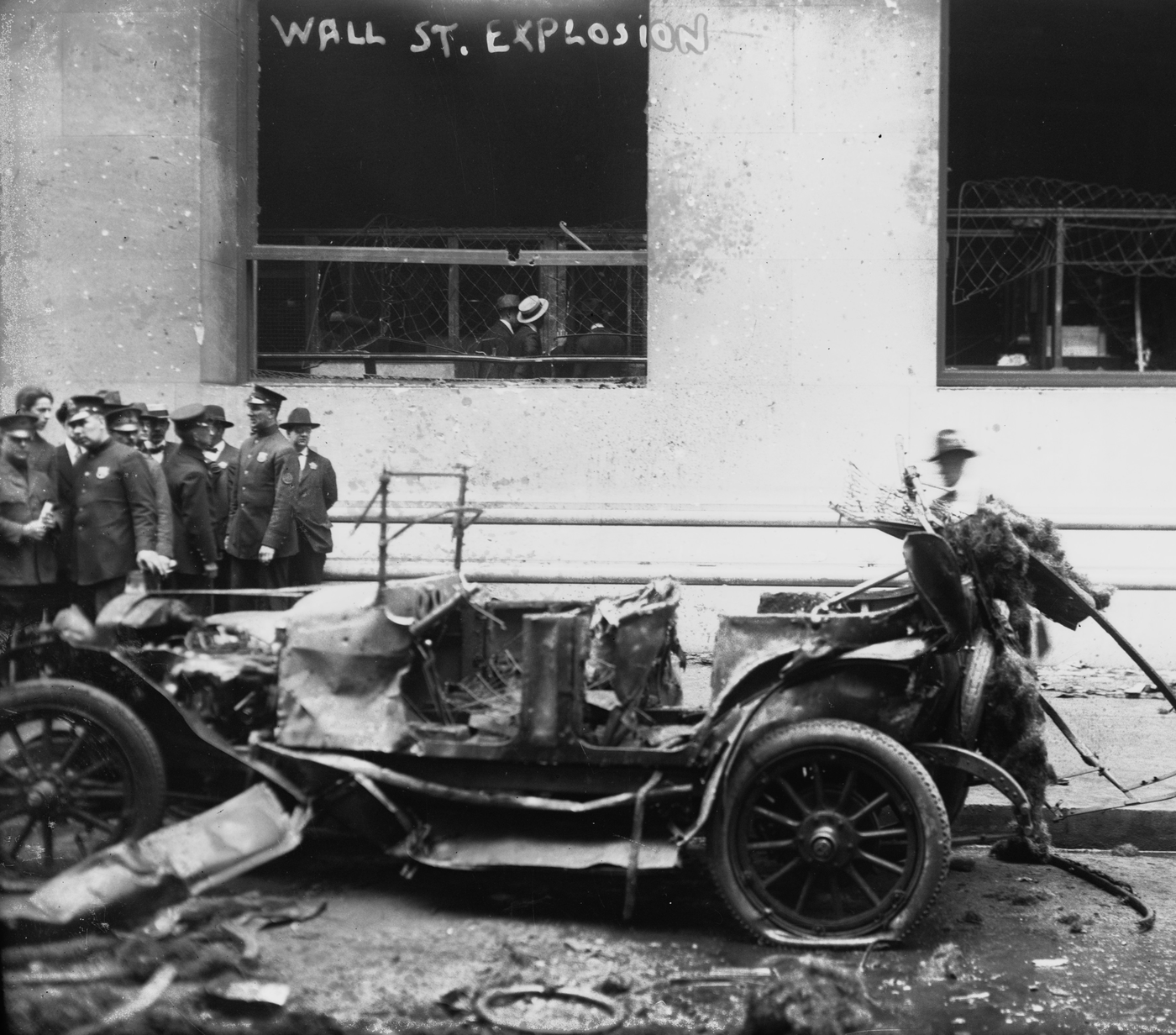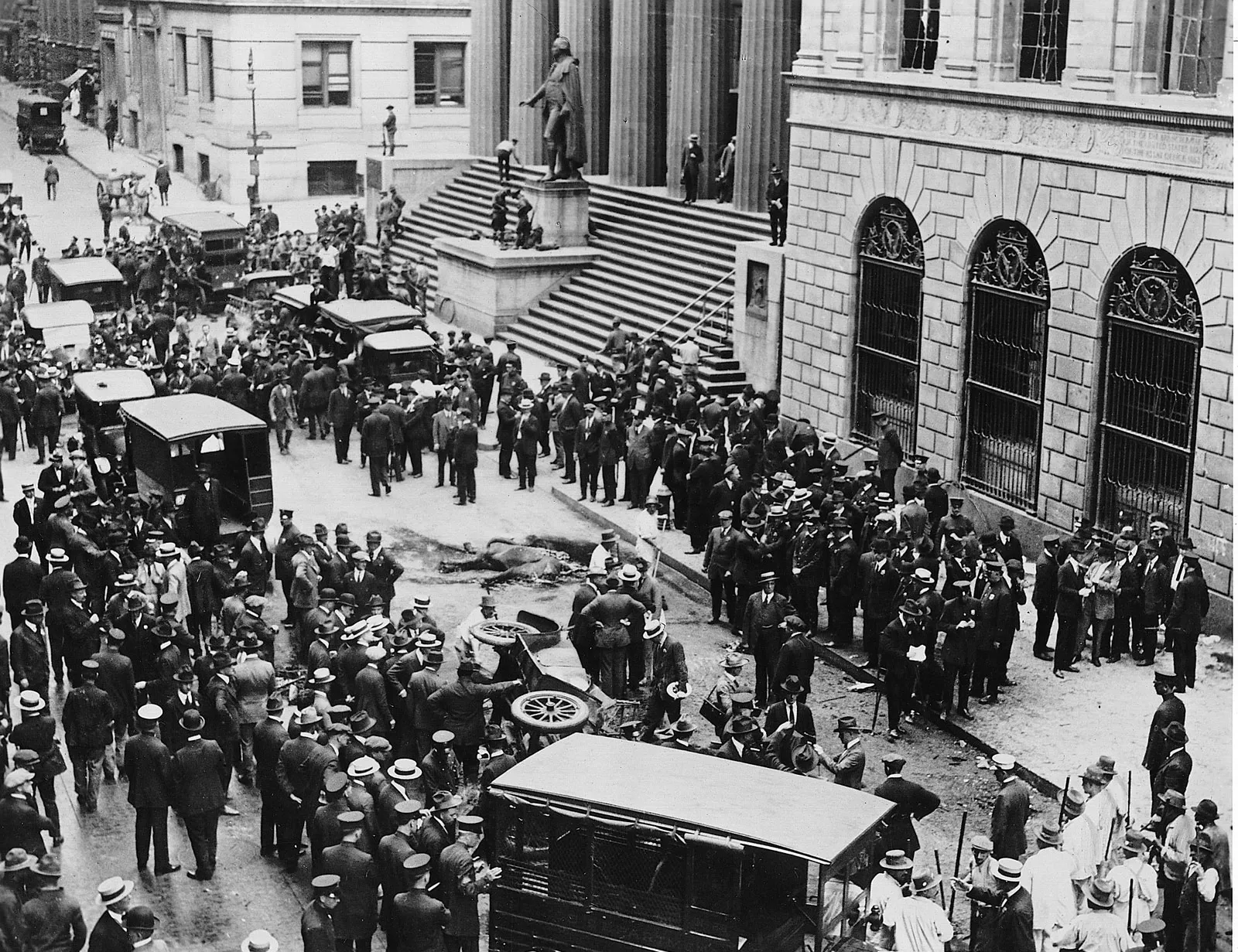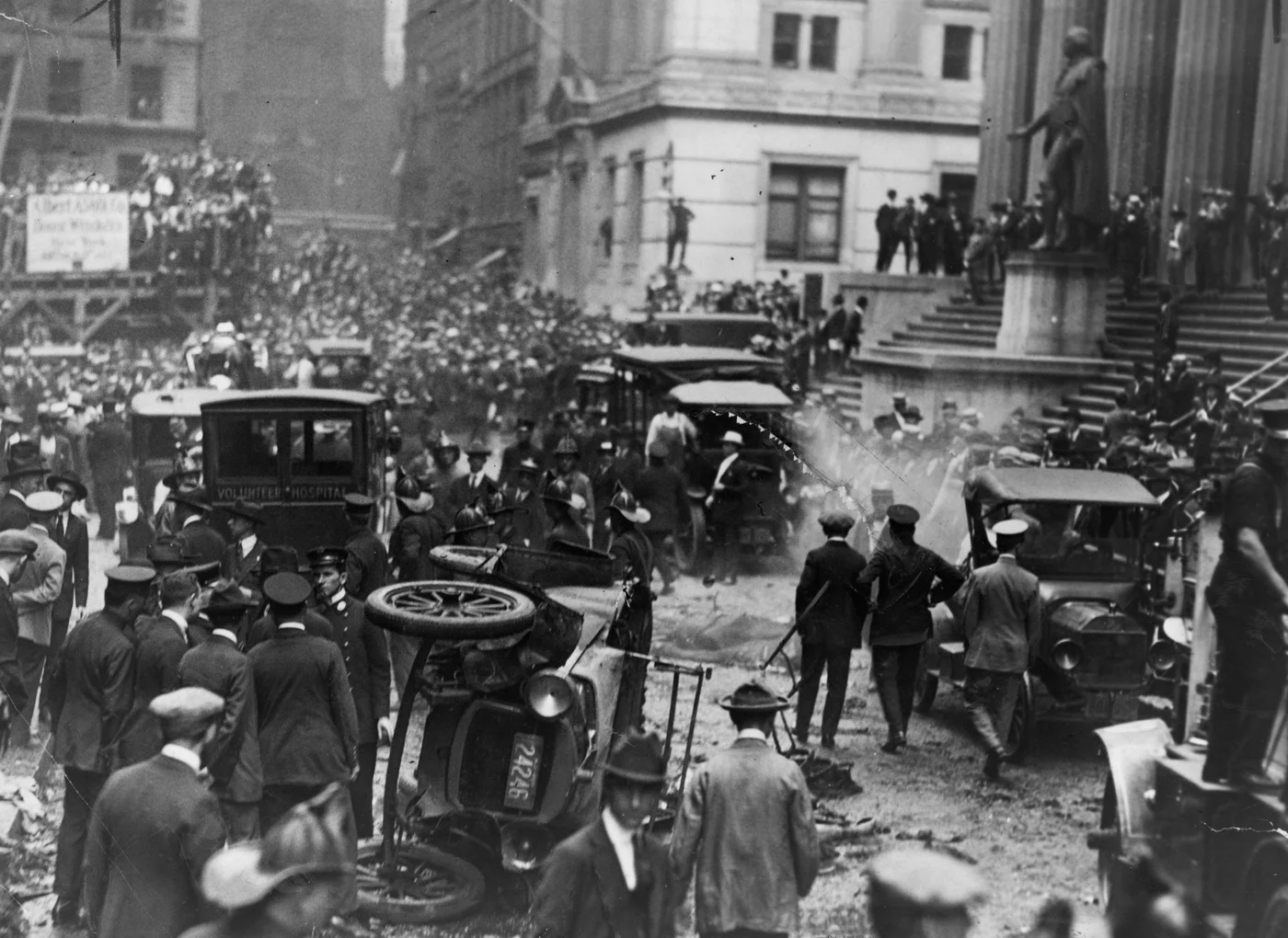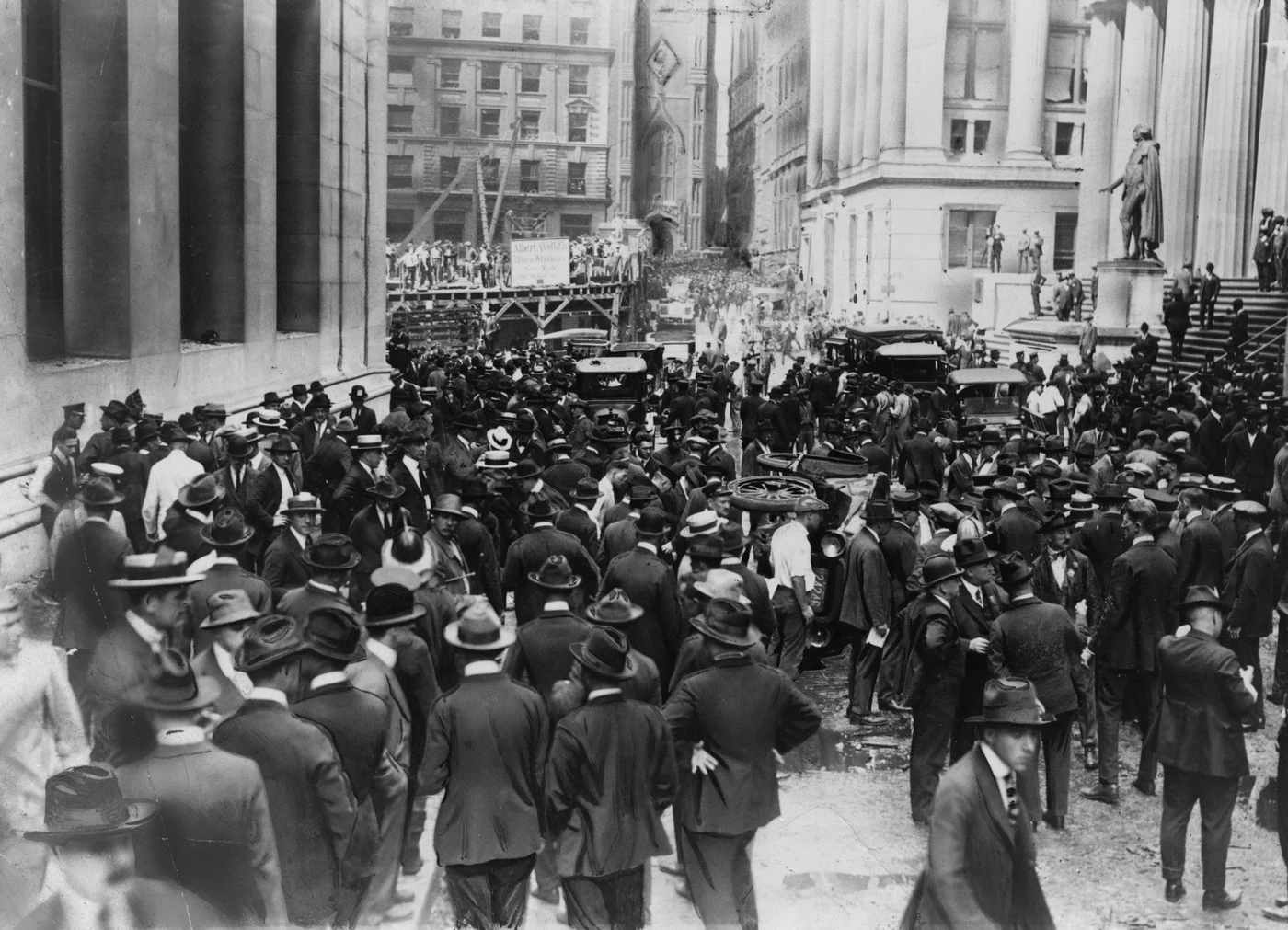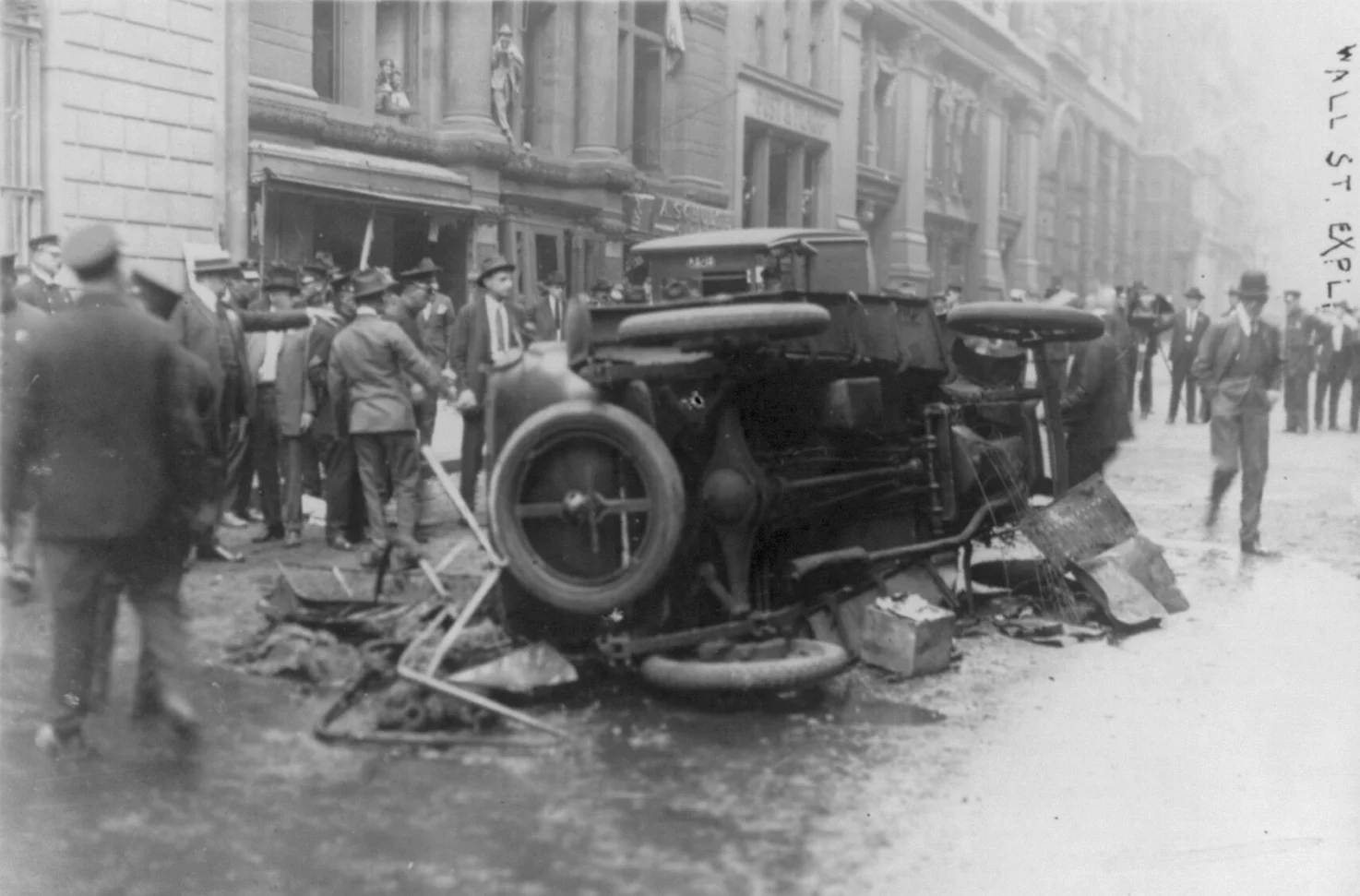The Wall Street Bombing of 1920: America’s Unsolved Mystery in the Heart of Finance
- dthholland
- Nov 11, 2024
- 5 min read

In the frenetic heart of Wall Street on a September day in 1920, just as the lunch rush was beginning, the unassuming sight of a horse-drawn cart parked outside the U.S. Assay Office held nothing to indicate the tragedy that was about to unfold. The cart was abandoned by its driver, who swiftly disappeared into the crowd, leaving the horse and its load behind. Moments later, an explosion shook the ground, sending a deadly hail of metal fragments and debris through the air. The bomb, packed with 100 pounds of dynamite and 500 pounds of heavy cast-iron sash weights, exploded with force and devastation, killing over 30 people instantly and injuring hundreds more. By the end of the day, the toll of lives lost had reached 40, and the city was left reeling from the deadliest act of terrorism it had ever seen.
The Wall Street bombing left lasting scars not only on its victims and their families but also on the iconic financial district itself. Over $2 million in damage (equivalent to around $30 million today) was inflicted on buildings and businesses, with the interior of the famed J.P. Morgan building suffering particularly heavy damage. This seemingly random, brutal attack shattered the usual hum of business in the area, sending clerks, brokers, stenographers, and messengers—many of them young people working their way up in finance—into a scene of unthinkable carnage. Yet, as the smoke cleared and emergency responders rushed in, the mystery of who was behind the attack would only deepen.
Immediate Response and The Shattered Calm of Wall Street
Almost instantly, Wall Street’s usual rhythm gave way to chaos as survivors scrambled for cover and bystanders joined in to help the wounded. Amidst the carnage, a 17-year-old messenger named James Saul commandeered a parked car to rush dozens of the injured to a nearby hospital, Police officers, too, sprang into action, requisitioning nearby vehicles to serve as makeshift ambulances.
In the offices of the New York Stock Exchange (NYSE), located just blocks away, the exchange president William H. Remick suspended trading to avoid a panic. New Yorkers gathered in shock as they tried to comprehend the magnitude of what had just occurred. Remarkably, by the next day, thanks to overnight cleaning efforts, Wall Street was open again, determined not to be cowed by the violence, though the psychological impact on the city would linger far longer than the physical scars.
Investigation and Theories: Anarchists, Communists, and Radical Intent
The Justice Department’s Bureau of Investigation (BOI), a precursor to the FBI found that their investigation stalled when none of the victims turned out to be the driver of the wagon. Though the horse was newly shod, investigators could not locate the stable responsible for the work. When the blacksmith was located in October, he could offer the police little information. Investigators questioned tennis champion Edwin Fischer, who had sent warning postcards to friends, telling them to leave the area before September 16. He told police he had received the information "through the air". They found Fischer made a regular habit of issuing such warnings, and had him committed to Amityville Asylum, where he was diagnosed as insane but harmless

The BOI, initially held back on labelling the attack as terrorism. But the nature of the bombing and the number of innocent casualties ruled out a mere accident, and officials soon turned their suspicions toward radical anti-capitalist factions. Anarchist and communist groups, particularly Italian anarchists and the Galleanists (who had been responsible for a spate of bombings in 1919), were high on the list of potential suspects. The choice of Wall Street as a target hinted that the bombers aimed to strike at the heart of American capitalism, and possibly J.P. Morgan’s powerhouse in finance.
One Galleanist in particular, Italian anarchist Mario Buda an associate of Sacco and Vanzetti and the owner of a car which led to the arrest of the latter for a separate robbery and murder, is alleged by some historians, to have acted in revenge for the arrest and indictment of Sacco and Vanzetti.
Buda's involvement as the Wall Street bombmaker was confirmed by statements made by his nephew Frank Maffi and fellow anarchist Charles Poggi, who interviewed Buda in 1955. Buda (at that time known by the alias of Mike Boda) had eluded authorities at the time of the Sacco and Vanzetti arrests, was experienced in the use of dynamite and other explosives, was known to use sash weights as shrapnel in his time bombs, and is believed to have constructed several of the largest package bombs for the Galleanists.

These included the Milwaukee Police Department bombing, which was a large black powder bomb that killed nine policemen in Milwaukee. However, he was neither arrested nor questioned by police.
After leaving New York, Buda resumed the use of his real name in order to secure a passport from the Italian vice-consul, then promptly sailed for Naples. By November, he was back in his native Italy, never to return to the United States.
The Role of Fear and Political Backlash
The Wall Street bombing triggered a reactionary wave of anti-radical measures in the U.S., with heightened efforts by both police and federal agencies to surveil and control suspected radicals. In response to the public outcry, the BOI expanded its intelligence operations under the leadership of a young J. Edgar Hoover, whose rise in federal law enforcement was significantly bolstered by public fears surrounding such acts of terror. The New York City Police Department also proposed forming a ‘special police’ unit to monitor ‘radical elements,’ adding further scrutiny to leftist organisations.

The bombing also took on symbolic weight, with some media outlets calling it an ‘act of war.’ The Washington Post was among the newspapers to make this declaration, reflecting the sentiment that America’s ideals were under attack, not only from external threats but also from within. For many Americans, Wall Street represented prosperity, freedom, and the American Dream, and the bombing was seen as a calculated attempt to destabilise that dream.
Unsolved Mystery: The Legacy of the Wall Street Bombing
Despite the BOI’s extensive investigations, the Wall Street bombing case remains unsolved to this day. The investigation hit a major roadblock when investigators were unable to identify the driver of the cart, and no conclusive evidence linked any specific group or individual to the attack. Theories have abounded over the years, and Mario Buda remains a prominent suspect in many historians’ eyes. Eyewitness accounts and circumstantial evidence suggest that he may have planted the bomb as a revenge act tied to the arrests of Sacco and Vanzetti.
However, no arrests were made, and the trail eventually went cold. Even with a re-investigation in 1944 by the FBI, the culprits behind the attack eluded identification. Investigators later ruled out many radical organisations, though they speculated that Italian anarchists may still have been involved.
Buda’s eventual departure to Italy and his subsequent silence on the matter have only added to the mystique surrounding the bombing. In later years, his nephew and a few close associates hinted at Buda’s involvement, lending weight to the theory that he was the mastermind. Yet, in the absence of a confession or tangible evidence, the bombing remains one of America’s most notorious unsolved cases.
The Unanswered Questions and Lessons from History
The Wall Street bombing of 1920 stands as a stark reminder of the tensions between progress and social upheaval. It marked a dark chapter in a post-World War I America, already divided by class struggles, labour strikes, and the Red Scare. The attack underscored the power of fear and distrust in shaping public policy and law enforcement strategies. It also highlighted the limitations of early 20th-century forensic investigation, where evidence could be swept away in an effort to ‘clean up’ and restore normalcy.
Today, the incident remains a lesser-known chapter of American history, often overshadowed by later events. Whether carried out by anarchists or an unknown third party, the attack has shaped the landscape of American security and serves as a cautionary tale of the unforeseen consequences that can follow unchecked political and social tension.






